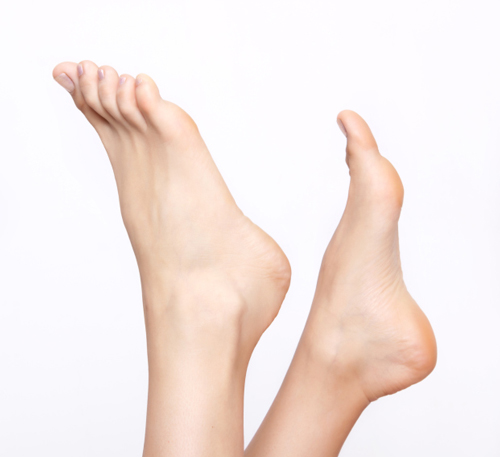 There is something comforting about gardening or walking barefoot during the summer months. The small muscles in the feet are often overlooked, but they are extremely important when it comes to stability and movement. In fact, they have a similar role to the abdomen’s core muscles.
There is something comforting about gardening or walking barefoot during the summer months. The small muscles in the feet are often overlooked, but they are extremely important when it comes to stability and movement. In fact, they have a similar role to the abdomen’s core muscles.
It turns out that “earthing” or walking barefoot is a scientifically proven practice. It has been found to reduce stress, improve sleeping habits, reduce inflammation, and increase antioxidants.
However, during the autumn and winter months there are fewer chances to walk around in bare feet.
Patrick McKeon is an assistant professor in the Department of Exercise and Sport Sciences at Ithaca College. His extensive and ongoing foot research suggests that walking barefoot indoors can greatly improve posture and balance. As a result, walking barefoot can also prevent common injuries like stress fractures, bursitis, shin splints, plantar fasciitis, and tendonitis in the Achilles tendon.
In his research, McKeon highlights a feedback cycle between the neural connections in the brain that send information from the larger “extrinsic” muscles of the leg and foot, and the smaller “intrinsic” muscles in the foot.
The interactions between the intrinsic muscles, extrinsic muscles, and neural connections are considered a very powerful tool, but when that feedback cycle is broken it can lead to injuries that cause harm to athletes and other active individuals.
According to McKeon, your shoes are the key culprits that break down the feedback cycle.
“When you put a big sole underneath, you put a big dampening effect on that information. There’s a missing link that connects the body with the environment,” explains McKeon.
Muscles are considered key force absorbers for the body, and without the nuanced information from the small foot muscles that going barefoot provides, the larger muscles are thought to overcompensate and cause overexertion to force exhaustion. When the extrinsic muscles in the feet cannot absorb the forces from everyday activities, that force is then transferred to your ligaments, tendons, and bones, and injuries will result.
McKeon is not opposed to footwear altogether. Certain shoe companies over the past 10 years have adopted barefoot shoes that are thought to reduce the injuries that are linked with running. For example, Vibram USA is the maker of the barefoot-style “FiveFingers” running shoes. These shoes are designed with individual pockets for each toe and the manufacturer claims they can help strengthen feet. However, lawsuits against the manufacturer allege the company misled customers as to the health benefits.
That being said, McKeon believes that minimalist shoe companies are on to something about their footwear. He stresses that people must transition to barefoot running, or minimalist running shoes, instead of doing it the right away. He recommends that five percent to 10% of your running routine be conducted barefoot or with minimalist shoes before switching to normal running shoes.
McKeon also suggests avoiding going barefoot in cold temperatures since it will decrease the body’s ability to sense pain. That is why activities like yoga, Pilates, dance, or martial arts are beneficial and help reintroduce feedback to the small muscles of the foot.
According to McKeon, a particular short-foot exercise will target the small muscles from squeezing the ball of the foot toward the heel. It can be performed standing or sitting, but it should be initially done with a physical therapist or trainer to gain familiarity of the movement.
McKeon has seen positive results from the exercise, especially in people with plantar fasciitis, shin splints, ankle sprains, and strains due to flat feet. He believes that the benefit can also be financial, as people could save hundreds of dollars on sneakers.
Finally, McKeon adds that being barefoot in indoor environments is the best way to start strengthening the foot’s small muscles. People can try going barefoot at home or at the office. Taking off your shoes at the recreation center when running a few laps is also an effective way to strengthen the foot muscles.
Sources for Today’s Article:
Shoemarker, S., “Going Barefoot: Strong ‘Foot Core’ Could Prevent Plantar Fasciitis, Shin Splints, and Other Common Injuries,” Ithaca College, November 17, 2015; http://www.ithaca.edu/news/releases/going-barefoot:-strong-foot-core-could-prevent-plantar-fasciitis,-shin-splints,-and-other-common-injuries-40536/#.VkyQZMqzBsN.
Chevalier, G., et al., “Earthing: health implications of reconnecting the human body to the Earth’s surface electrons,” Journal of Environmental Public Health, 2012; 2012:291541, doi: 10.1155/2012/291541.
Eliaz, I., “The Surprising Health Benefits Of Going Barefoot,” MindBodyGreen web site, April 27, 2013; http://www.mindbodygreen.com/0-9099/the-surprising-health-benefits-of-going-barefoot.html.
